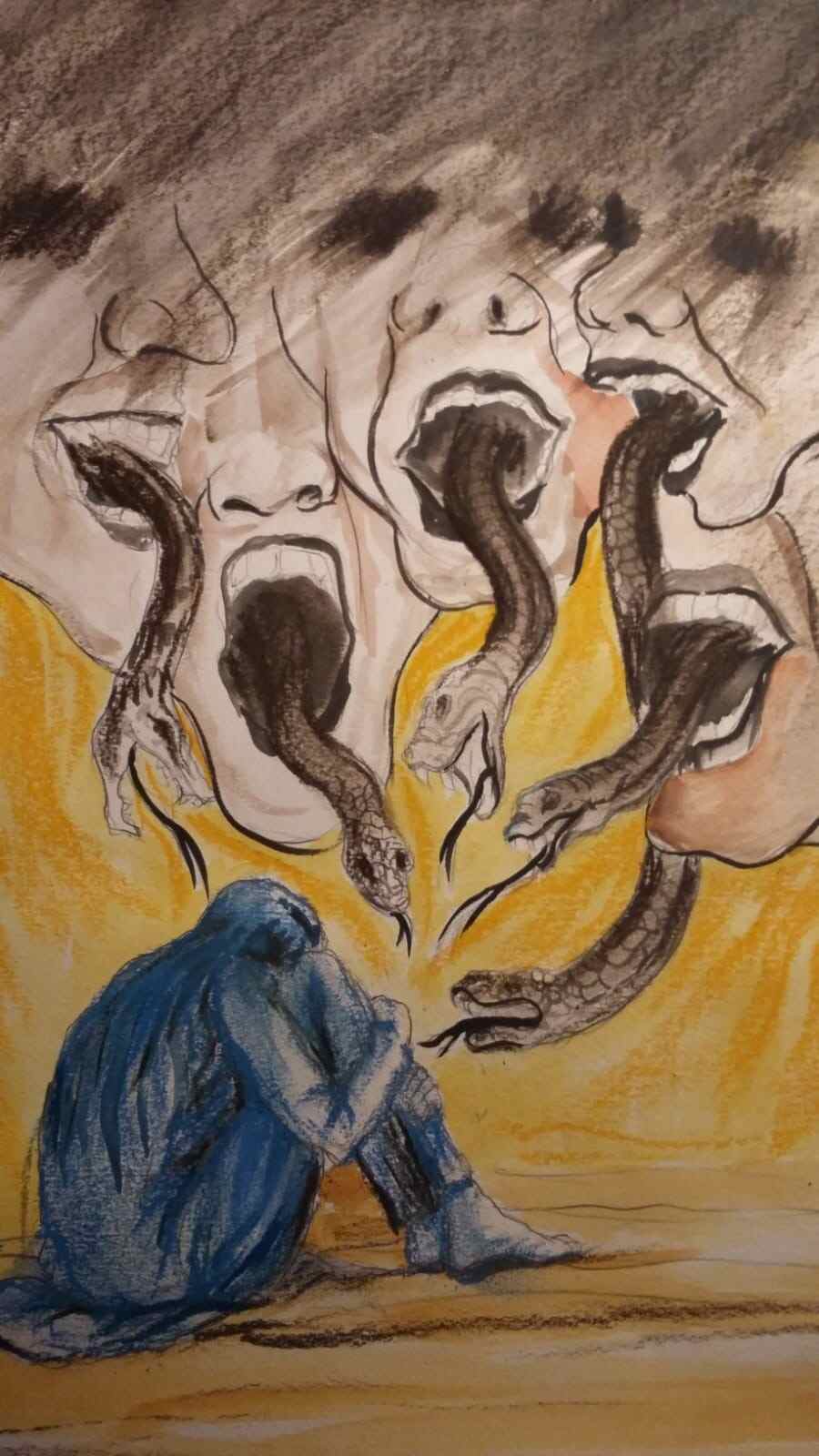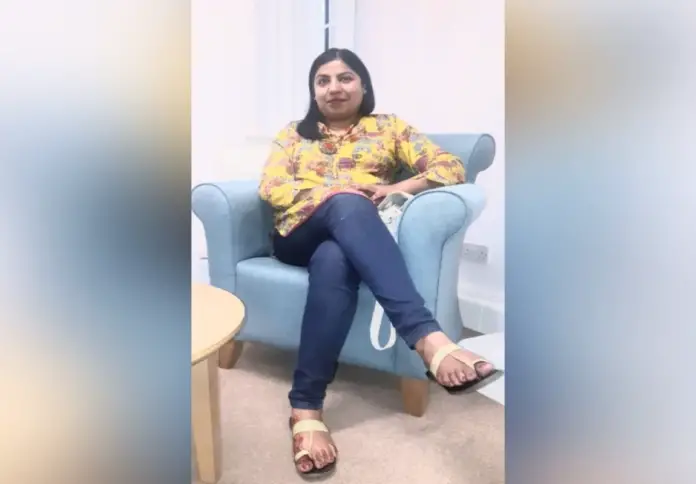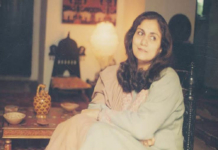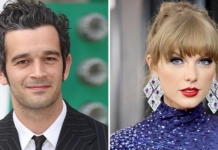Having her roots in Pakistan but being based in the UK for over twenty years now, Naheed Chatha is one such painter whose works act as pathways towards the problems a modern person encounters, be it their struggles to carve a place for themselves in an unforgiving society, or the psychological ailments which are now a global issue.
Her artworks play a trick of attracting the on-looker with a use of vibrant colors. But once hooked, the observer realizes that the colors depict the superficiality of our society, while underneath lies the sadness, depression and anxiety, thereby making Naheed Chatha’s works somewhat expressionistic.
Chatha attained the top position in Fine Arts at intermediate level from Sialkot Degree College and University. Then she settled in Lahore for a major MFA degree from the prestigious Punjab University’s Fine Arts department, earning a scholarship for herself to study fashion and design at Nottingham Community College, England. She keeps herself updated with the artistic scene in Pakistan, remaining in touch with the head of University College of Fine Arts and the leading vocational institute of art and fashion based in Gulberg by the name of STEPS. Minute Mirror asked a few questions from the Pakistani-British artist, the answers of which are as follows:
When and why did you plan to leave Pakistan?
It was a completely unplanned move. It was a gradual process which commenced around 1999, when I was awarded a scholarship to study fashion and design at Nottingham Community College, Nottingham, England. Initially I went to study but was offered a position of a lecturer which I accepted. Life took me into getting commissions of my paintings by local people in England at the same time and I didn’t realize how and when I made my home in the UK.

Being a Pakistani by birth, how did you manage to carve a niche for yourself in the artists’ circle of England?
With the perspective of an artist which I carried with myself, I found myself immersed in another world, a new environment altogether which enabled me to consider things relatively and make comparisons. The environment of the Fine Arts’ department of Derby University was completely different from that of Punjab University’s department of the same field. We had artists of various age groups, from their 20s to their 80s, with all of them coming from different walks of life, holding a variety of skills, experiences, artistic abilities and knowledge. I learnt a lot about art while sitting in their company as well as my own study sessions during university timings. I also joined Derby Sketching Club where all the local senior artists meet on weekly basis and practice art, where I was able to spend time drawing, painting and learning in the most friendly and protected atmosphere. Through the platform of that sketching club, I managed to enter in art competitions and group exhibitions, and was awarded the best artist ability award in 2017.

How is Western art different from Pakistani art in terms of style and thought? Or are the genres more or less the same, with the differences being temporal mostly?
I witnessed that Pakistani artists are managing to escape the influences of the schools and their academicism, and also the influence of Asian culture. The internet has become a real teacher which has made this world a global village. Now, my eyes get the feast of seeing the production of art as a mixture of Arabic calligraphy, Asian vibrant colors, English styles and subject matters common to the whole world.
Living in England, how do you keep yourself updated with Pakistani art? What is currently happening in Pakistani art? Is it in any way reflective of its imbalanced socio-political system?
It is through social media that I remain in direct contact with the leading artists residing in Pakistan as well in other parts of the world. We manage to talk and share each other’s work with clear recognition of visual confusion and differing viewpoints, the motive being to resolve them while satisfying peer artists and viewers. I also visit Pakistan, meet the artists working actively and producing good art.
Once you attain a degree in a subject, it is required of you to keep yourself updated with the latest trends in the field. In this competition, how do you do your personal catharsis through art?
I do things that are contradictory. I like to make art look like it’s part of the world. In my style subject matters and techniques, there are restless experiments and there is no such thing as a typical production. I just paint as if I am putting my feelings and thoughts on a piece of paper or a canvas. I correspond through colors, giving the viewers ample margin to make out their own meaning through the work.
You did an exhibition on women’s rights a long time ago at Alhamra Arts Council, Lahore. Now that cases of violence against women have grown even more, do you have any plans to hold another exhibition in order to create awareness?
I believe that multiplication has become one of the most familiar gestures. Demonstrating the effect of media representation in space through millions of identical editions, and television and social media chewing again and again at a particular event in the form of a piece of writing or visual art dulls the senses and generalizes the responses of an artist as well as of the viewers. The success of my exhibition on the discrimination of women in South Asian countries encouraged me to pursue my own course. Seeing that it would be easy to exploit the style so well-received by the public, I changed my subject and worked on from large-scale compositions to thoughtful still-life projects while also adding subtle references to a classic burial of sad topics.

In a country like Pakistan which keeps regressing amidst short and negligible episodes of progress, has art progressed or regressed?
Modern art, or the art of whole of the 21st century is much more than just an expression of circumstance. I believe that Pakistani artists are producing a marvelous work of art in all its forms, for example, the modern calligraphy with mix media paintings are the answer to the problem of unbridled emotions in the modern artist’s work of art in Pakistan. That is exactly what writer Karl Kraus describes as a “riddle out of a solution”. I believe that the approach of an artist in Pakistani at present in intelligent. I see the realistic compositions by Dr.Samina Nasim in Lahore, water-color landscapes by Noman Khan Nomi in Karachi, modern calligraphy by Masood Akhtar in Lahore and a number of artists producing work from realism to post-impressionism determine the largest intellectual revolution in visual art in Pakistan.
Syed Arslan Naqvi who is painting crows and street children is a proof of progress in art in Pakistan which shows that the current circumstances of the country are actually supporting artists to produce good work, a by-product of which is also a spiritual (sufi) dimension to the modern art which, however, has little to do with unforeseen events. Last but not the least, we should not ignore the Truck Art taking a huge place in modern art and fashion outlets. This art with its bold designs and vibrant colors is getting very popular internationally which has purely originated from Pakistan. In the most recent times, it is not only the traditional ways of producing art which come into play but there are technological ways as well which stimulate visual arts. Mohni Saif in Lahore is the person to be given the credit for composing the curriculum and looking into the theoretical side of art education in the fields of fashion, digital arts and painting.







